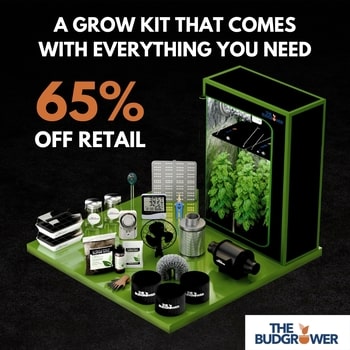Welcome to the ultimate guide to LED grow lights! This article will explore the benefits of using full-spectrum LED grow lights for indoor plants. From helping your plants thrive during all stages of growth to saving energy and producing less heat, LED grow lights are a game changer for indoor gardening enthusiasts.
Our guide to LED grow lights covers everything you need to know, from how they work to choosing the best one for your needs.
Understanding LED Grow Lights
LED grow lights have become increasingly popular in recent years for indoor plant growing. They are energy-efficient, long-lasting, and provide a full spectrum of light essential for plant growth. Whether you are growing vegetables, herbs, flowers, or any other type of plant, LED grow lights can help you achieve healthy and vibrant growth year-round.
How do LED Grow Lights Work?
LED grow lights emit a specific spectrum of light optimized for plant photosynthesis. Unlike traditional light sources such as incandescent or fluorescent lights, LEDs produce light more tailored to plants’ needs. They emit light in wavelengths efficiently absorbed by plants, allowing them to grow and thrive indoors.
Benefits of Using LED Grow Lights
LED grow lights offer numerous benefits for indoor plant growth. Some of the key advantages include:
- Energy Efficiency: LED grow lights use significantly less energy than traditional lighting sources, making them more cost-effective and environmentally friendly.
- Longevity: LEDs have a longer lifespan than other types of lights, reducing the need for frequent replacements.
- Full Spectrum: LED grow lights provide a full spectrum of light that promotes healthy plant growth and flowering.
- Customizable Spectrum: Some LED grow lights allow you to adjust the light spectrum according to the specific needs of your plants.
- Low Heat Emission: LED grow lights produce less heat than traditional lights, reducing the risk of plant damage from overheating.
Choosing the Right LED Grow Light
When choosing the right LED grow light for your indoor garden, several factors must be considered. From light spectrum to intensity, here are some key aspects to remember when selecting the best LED grow light for your plants.
Light Spectrum
The light spectrum produced by LED grow lights plays a crucial role in plant growth and development. Different plants require different light spectrums at various stages of growth. Here are the essential spectrums to consider:
- Blue Light: Blue light is essential for promoting vegetative growth in plants. It is ideal for seedling and young plant growth.
- Red Light: Red light is crucial for stimulating flowering and fruiting in plants. It is essential during the flowering and fruiting stages.
- Full Spectrum: Some LED grow lights provide a full spectrum of light that includes both blue and red wavelengths, catering to the complete growth cycle of plants.
Light Intensity
Another essential factor to consider is the light intensity emitted by LED grow lights. Different types of plants require varying levels of light intensity for optimal growth, so it is essential to ensure that the LED grow light you choose can deliver sufficient light intensity for your specific plants.
Coverage Area
The coverage area of an LED grow light determines how much space it can effectively illuminate. Consider the size of your indoor garden or grow space when selecting an LED grow light. Choose a light that can adequately cover the entire area to ensure all plants receive the necessary light for healthy growth.
Wattage and Power Consumption
LED grow lights come in various wattages, which can impact their power consumption and output. Higher-wattage lights consume more power but can provide greater light intensity and coverage. Consider the wattage of the LED grow light based on the size of your grow space and the light requirements of your plants.
Types of LED Grow Lights
LED grow lights come in different types and configurations, each designed to cater to specific plant needs and grow spaces. Understanding the various types of LED grow lights can help you make an informed decision when selecting the best option for your indoor garden.
Panel Lights
Panel LED grow lights are flat and rectangular, designed to cover larger grow areas. They provide a uniform light spread over the plants and are ideal for increasing multiple or larger crops. Panel lights are versatile and can be used for various types of plants.
Bulb Lights
LED bulb grow lights are compact and versatile, suitable for smaller grow spaces or individual plants. They can be used in regular light sockets, making them easy to install and convenient for small indoor gardens. LED bulb lights are cost-effective and energy-efficient, ideal for beginners or hobbyist growers.
Spotlight or Floodlight
Spotlight or floodlight LED grow lights are highly concentrated and intense, providing targeted light for specific plants or areas. They are ideal for plants that require high light intensity or supplemental lighting. Spotlight or floodlight lights are often used with other LED grow lights to provide additional light.
Strip Lights
LED strip grow lights are flexible and customizable, making them suitable for irregularly shaped or narrow grow spaces. They can be cut to size and adjusted to fit any area, providing uniform light coverage for plants. LED strip lights are versatile and can be used for various plants, from seedlings to flowering plants.
Setting Up Your LED Grow Light System
Once you have chosen the right LED grow light for your indoor garden, it is essential to set up the lighting system for optimal plant growth properly. Proper installation and positioning of the LED grow lights can significantly improve the health and development of your plants.
Hanging Height
The hanging height of LED grow lights is crucial in determining the light intensity and coverage for plants. Different types of plants require varying amounts of light, so it is essential to adjust the hanging height accordingly. As a general guideline, hang the LED grow lights closer to seedlings and young plants and raise them higher as they grow taller.
Light Schedule
Establishing a consistent light schedule is vital for the growth and development of plants under LED grow lights. Most plants require around 12-16 hours of sunlight daily for optimal growth. Create a regular light schedule that mimics natural daylight patterns to promote healthy plant growth. A timer will automate the lighting cycle and ensure plants receive light exposure.
Light Distance
The distance between LED grow lights and plants can impact the intensity and coverage of light. It is essential to maintain the correct distance to prevent light burn or shading of plants. Refer to the manufacturer’s recommendations for the optimal light distance based on the specific LED grow light you are using. Monitor plant response and adjust the light distance to ensure healthy growth.
Light Placement
Proper placement of LED grow lights ensures uniform plant light distribution and coverage. Position the lights strategically to cover all plants in your growing space effectively. Use reflectors or light diffusers to redirect light and minimize shadows, ensuring all plants receive the necessary light for healthy growth. Experiment with different lighting configurations to find the best setup for your specific plants.
Maintaining Your LED Grow Light System
Proper maintenance is essential to ensure the longevity and efficiency of your LED grow light system. Regular care and upkeep can help prolong the lights’ lifespan and ensure optimal performance for your plants. Here are some maintenance tips to keep your LED grow light system in top condition:
Cleaning
Regularly clean the surface of LED grow lights to remove dust, dirt, and debris that can obstruct light output. Use a soft, lint-free cloth or a gentle brush to wipe down the lights and keep them free from buildup. Avoid using harsh chemicals or abrasive cleaners that can damage the light fixtures.
Inspecting
Periodically inspect the LED grow lights for any signs of damage, wear, or malfunction. Check the wiring, connections, and components for loose parts, corrosion, or other issues that may affect performance. Replace faulty bulbs or components promptly to ensure consistent light output and plant growth.
Cooling
LED grow lights produce heat during operation, which can affect the temperature of the grow space. Ensure proper ventilation and cooling to prevent overheating and damage to the lights or plants. Use fans or exhaust systems to regulate the temperature and maintain a comfortable environment for plant growth.
Upgrading
As technology advances, newer and more efficient LED grow lights become available. Consider upgrading your lighting system periodically to take advantage of innovations and improvements in LED technology. Upgrading to newer models can enhance light output, energy efficiency, and overall performance for your indoor garden.
Troubleshooting Common Issues with LED Grow Lights
Despite their many benefits, LED grow lights may encounter some common issues that can affect their performance. Knowing how to troubleshoot these problems can help you address them promptly and maintain healthy plant growth. Here are some common problems with LED grow lights and potential solutions:
Light Flickering
If your LED grow light flickers or flashes intermittently, there may be an issue with the power source or wiring. Check the connections and power supply to ensure a stable electrical connection. Replace any faulty components or wiring that may be causing the flickering.
Uneven Light Distribution
Uneven light distribution can occur if the LED grow lights are not positioned correctly or if obstacles block the light. Adjust the placement of the lights and use reflectors or diffusers to redirect light and minimize shadows. Ensure that all plants receive equal light exposure for uniform growth.
Burnt-out LEDs
Over time, individual LEDs may burn out or stop working, affecting the overall light output of the grow light. To maintain consistent light intensity and spectrum, replace any burnt-out LEDs promptly. Check the manufacturer’s guidelines for replacing LEDs and follow the recommended procedures.
Heat Buildup
LED grow lights can generate heat during operation, which may require additional cooling or ventilation to prevent overheating. Ensure proper airflow and cooling in the grow space to dissipate excess heat and maintain a comfortable plant environment. Use fans, heat sinks, or exhaust systems to regulate the temperature and prevent heat-related issues.
Conclusion
LED grow lights offer a sustainable and effective lighting solution for indoor plant growth, catering to plants’ specific light requirements at different growth stages. By understanding how LED grow lights work, choosing the right type for your plants, and correctly setting up and maintaining the lighting system, you can create an ideal environment for healthy and vibrant plant growth year-round. Whether a beginner or experienced grower, incorporating LED grow lights into your indoor garden can help you achieve exceptional results and take your plant-growing adventures to the next level. Happy growing!













